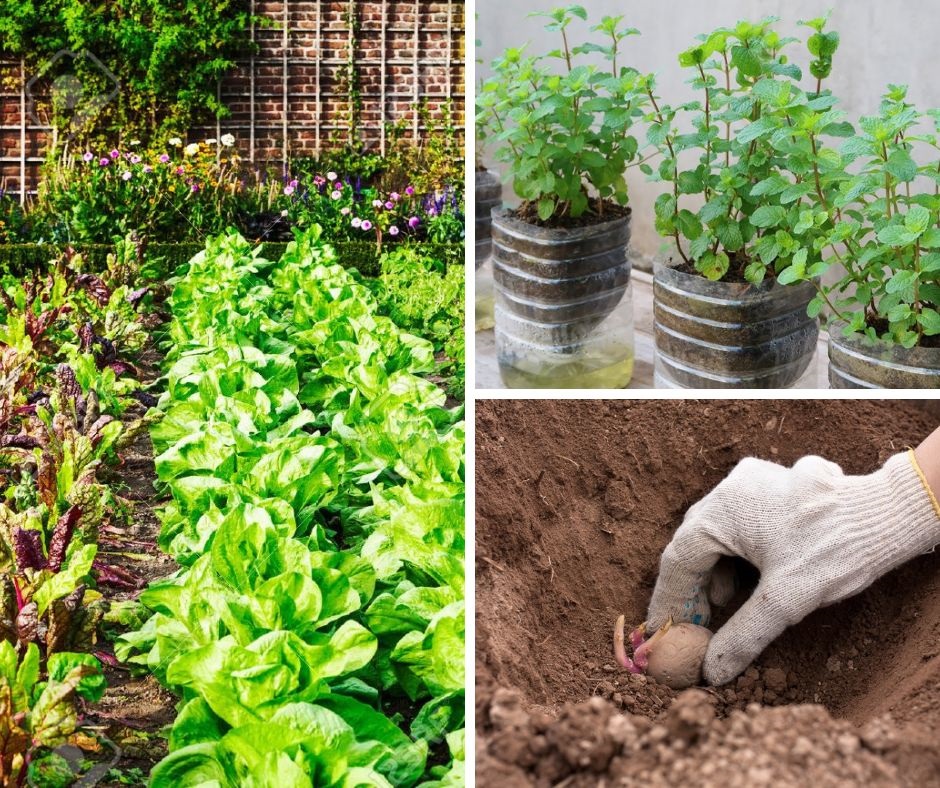There is no need to spend a fortune on a vegetable garden or kitchen garden. You don’t need to spend a dime on most of the essentials to get started.
As a way to help new gardeners get started on the path to greater resilience and self-sufficiency, here are some zero-cost tips for planting a vegetable garden right now:
THE BASICS: START GROWING AT ZERO COST
To begin, keep in mind that most of the things plants require to develop are already there. Sunlight, nutrients from the soil and air, and water are all necessities for plants.
Nature already offers a lot of what you need for gardening, despite the fact that it can appear complicated at times. Seeds, time, and a little work are all you’ll need to get started.
Being sure to meet your garden’s long-term demands won’t set you back a dime. So, let’s see how you may keep your garden healthy and fertile for years to come without having to invest a penny:
Composting
Composting is an essential part of an organic garden’s overall operation. It is the process by which we ‘recycle’ good waste and other biodegradable materials and return the nutrients contained in them to our growing areas.
It is possible to increase your self-reliance and establish a long-term, self-sustaining growing system by installing a composting system on your property.
Composting For Free
Here are some tips to help you get started with a free composting system:
Creating a simple compost bin or cold compost heap is as simple as creating a heap in the corner of your property. Use materials you already have or can get for free to keep the compost contained and to keep things looking nice. There are a variety of materials that can be used to build a compost bin structure. Compost bins can be made from reclaimed wood, such as old pallets or scrap fencing. Recycled barrels or drums can also be used for this purpose.
Composting kitchen wastes in an upcycled 5-gallon bucket is a simple, cost-effective solution. Old food containers or storage bins might be utilized for this purpose.
You can also experiment with vermicomposting or use a bokashi system to boost the amount of compost you can produce.
Another approach for composting is to just compost in place, which can do two things at once. In the section where we discuss creating a new growing space, you’ll learn more about composting in place.
More Fertilizers at No Cost
Gardeners have other options besides composting when it comes to replenishing the soil’s nutrients. You can also produce your own free fertilizers and fertility boosters for your plants by repurposing free things around you.
For instance, you could:
Make leaf mold out of fallen leaves from your garden in the fall.
Make use of free or low-cost mulches like comfrey or grass clippings, as well as other natural materials around your home (e.g. seaweed, bracken, straw, leaves etc..).
Comfrey can be used to make liquid fertilizers for your garden.
You should never have to buy fertilizer for your garden if you employ these strategies and all the organic stuff you have at your disposal.
When planning your vegetable garden, keep in mind whether or not you’ll have to water it by hand.
Even if you grow your vegetables in the open air, it is likely that you will need to water your garden at some point during the year. Even in locations with significant rainfall, dry spells can occur frequently throughout the spring and summer.
Collecting Rainwater
The first thing you can do is think about how you can manage the rain that does fall on your land. Storage options for water include:
- the actual trees and plants that make up the landscape.
- the soil.
- ponds, reservoirs, and basins.
- Barrels, cisterns, or rainwater tanks are all viable options.
If you have the ability to collect and store extra water on your land, all the better. The following factors can affect how much water our gardens collect and store:
- selecting appropriate plants and avoiding any bare soil as much as you can is essential.
- Mulching and earthmoving can help keep water in the soil longer.
- Adding organic stuff to the soil to enrich it.
- The act of excavating a body of water. (These can be dug by hand on a modest scale.) By using natural clay from your property, you may even be able to eliminate the expense of installing pond liners or equivalent and keep your costs at zero
- Capturing rainwater that falls from the roofs of your home and any other buildings or structures on the property. Creative gardeners may be able to put up free watering systems by using repurposed pipes and gutters, as well as reclaimed containers like old barrels or drums to hold water.
- When it rains, you can collect some water for your vegetable garden by putting buckets and other containers outside.
Catching and storing rainwater is an obvious way to save money for anyone with a water meter. However, there is a slew of additional benefits, both immediate and long-term, to collecting rainwater in your garden.
Developing Biodiverse, Thriving Ecosystems
Another thing to keep in mind when you design your vegetable garden is that it will be hardier if it is more diversified. Over time, the more resilient your garden is, the easier it will be to maintain it at no expense and without the use of pesticides.
Maintaining a wide variety of plants and animals in your kitchen garden is essential to its success. You’ll be able to save a lot of money, time, and effort if you do that.
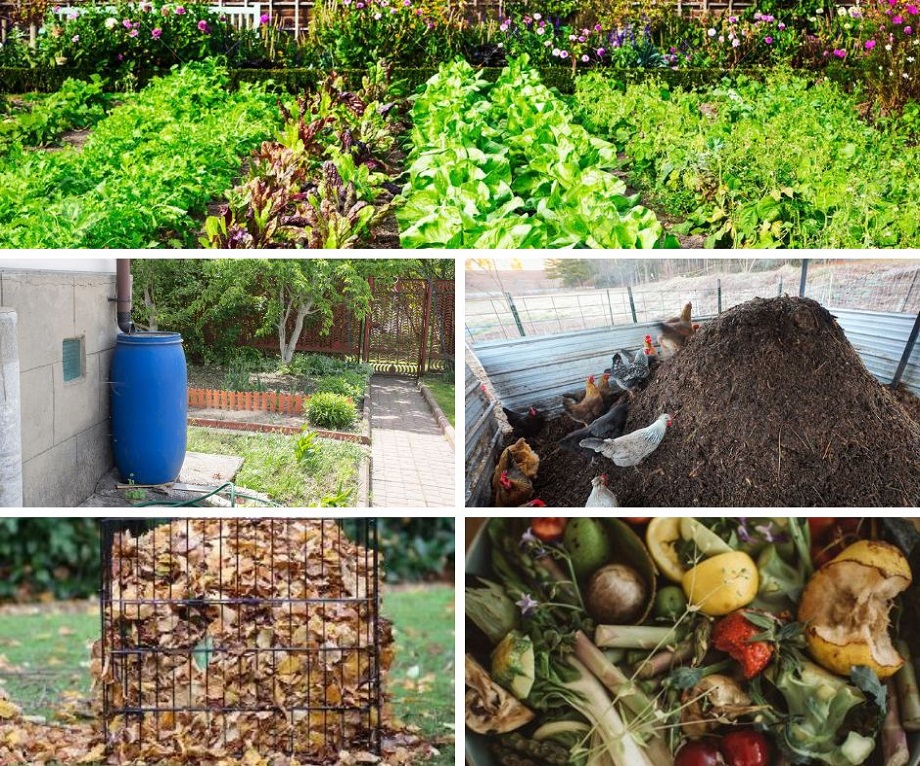
TIPS FOR SOURCING GARDEN TOOLS AT ZERO COST
Even if you aim to grow a low-maintenance garden, you’ll still need a few tools to get the job done. You may be concerned about the cost of acquiring these products.
However, the good news is that you don’t have to spend a lot of money on tools. In some cases, it may even be possible to receive all you need for nothing.
When starting a low-cost or no-cost vegetable garden, keep in mind that fewer tools are usually better.
The use of ‘no-dig’ gardening techniques, which means that there will be no digging and a lot less manual labor, is strongly recommended by us. A shovel or spade may still be necessary for moving materials.
To get you started, here’s a list of the most essential tools for your vegetable garden:
- a shovel or a spade
- Garden fork.
- Small trowel.
- a pair of secateurs or garden shears.
- A wheelbarrow
Even though there are many additional tools that may be useful, these are the essentials that you should have at the start. Extras are welcome but aren’t absolutely necessary. It’s possible that you don’t need all of these.
Getting Tools For Free
There is no guarantee that you will be able to get free garden tools unless you have the ability to create your own. However, there are a lot of options you might explore before making a final decision. You could:
Find out if anyone in your circle of friends or family has any extra tools they don’t use.
Find out if there is a gardening club in your neighborhood that has a tool resource you may use.
Freecycle, Freegle, or Gumtree are all good places to look for freebies. Remember that even rusty or broken instruments can be repaired if they’re in good condition.
Check your local yard sales, thrift stores, and antiques stores for old tools that could be used. New wooden handles can be made from branches from your own backyard using the metal ends of garden equipment.

TIPS FOR GROWING A NEW GROWING AREA WITHOUT SPNDING A DIME
So, you’ve got the basics in place and the tools you’ll need to get started. What’s next?
You might be surprised at how simple and inexpensive it is to create a new growth space.
Your new growing area is ready for construction, so get to work!
Growing Spaces for Free in the Open Air
The location of your new vegetable patch should be your first consideration when setting up an outdoor growing space. When it comes to long-term costs, the appropriate location could make a major impact. Your new kitchen garden’s yield could be significantly affected as well.
Aside with sunlight and shade, watersheds and soil quality are other important considerations. The location of your vegetable garden in relation to other components of your yard, such as the kitchen door and your compost heap, should also be taken into account. The easier it is to tend your vegetable patch, the less waste you’ll produce in the long run.
You’ll also need to decide if you want to grow in the ground, or if you want to build raised beds. Generally speaking, it is less expensive to grow plants underground than on top of a raised bed. New beds don’t require any work on your part in terms of edging or filling.
Filling your beds won’t be a problem, though, if you use the ‘lasagna’ style of construction. It’s possible to get free raised garden bed edging as well, so don’t forget that.
Ground-Level Growing
A ‘created’ growing area may not be necessary if you start with bare, fertile soil. You never know, it could be right there, just waiting for you to find it. It’s also a good idea to put a cover crop or green manure in the area if it’s lacking in fertility before you start growing vegetables.
It’s possible that grass, overgrown, or poor-quality soil would necessitate some preparatory work before you can plant.
Fortunately, this project will cost nothing and require just resources that you may already have on hand from your land and the nearby neighborhood.
Lasagna Beds
In the same manner that lasagna is made in the kitchen, lasagna beds are made in the garden. Instead of layering spaghetti, tomato sauce, and the like, you’re constructing a structure out of organic components.
Creating lasagna beds on lawns or in your garden is an excellent method to expand your growing space. You can create additional areas for a kitchen garden and compost materials in place, rather than in a separate zone, much like you would a traditional compost heap, with layers of brown (carbon-rich) and green (nitrogen-rich) materials.
When making a lasagna-style garden bed, cardboard is typically laid down first. Even though it’ll eventually degrade, it’ll help keep grass and weeds out of your newly planted vegetable garden.
Next, you’ll cover the cardboard in brown and green materials. Most of the time, you can get these for free.
You may be able to obtain brown stuff for free, such as:
- card and paper that has not been handled
- dead leaves and branches
- Chips of wood or other woody stuff
- straw
- bracken
You may be able to obtain green products for free, such as:
- leftovers from your kitchen’s food waste
- grass clippings
- green leaves
- seaweed
If you don’t have access to soil or compost, you may have to buy a little amount of high-quality peat-free compost to top your garden bed. In contrast, if you build your own composting system, you will only have to pay once.
Raised Beds
In the same way, as described before, raised beds can be constructed from the ground up. Keep adding organic stuff until you reach the appropriate depth. Raised beds will eventually sink due to the decomposition of the materials, but you can prevent this by putting mulch on the top.
However, what about the raised bed’s perimeter? Fortunately, there is a slew of cost-free options for natural and repurposed bed edging.
You could also want to experiment with hugelkultur, which is a distinct kind of raised bed. Make your own straw bale garden if you have access to free straw bales in your area.
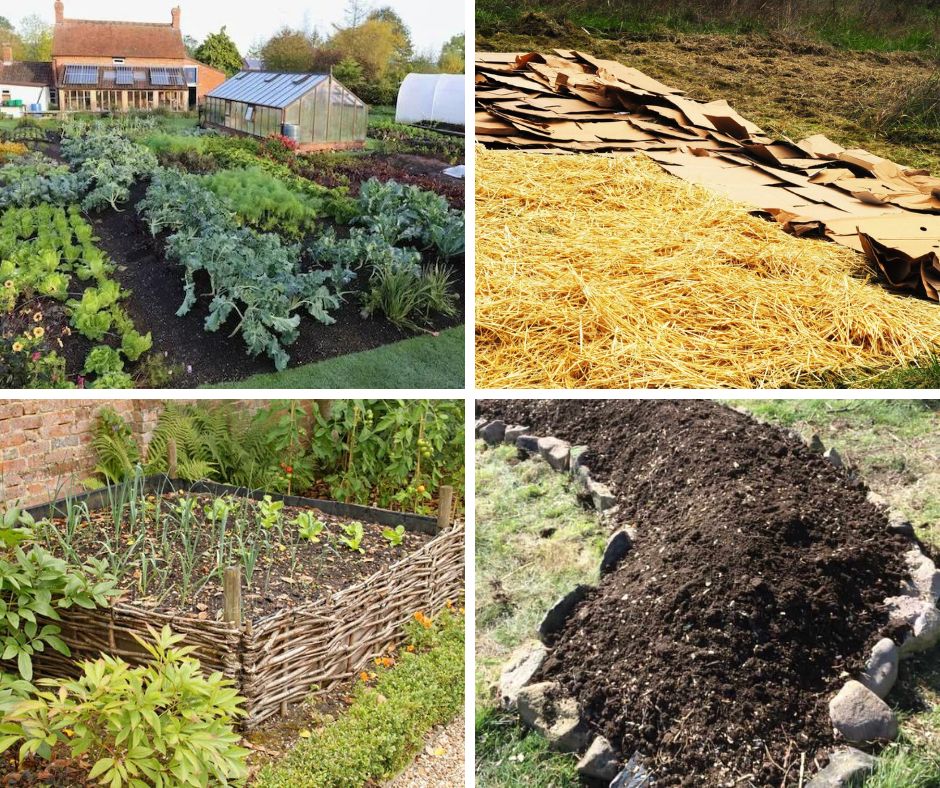
Greenhouses/ Under Cover Growing Areas At Zero Cost
A zero-cost greenhouse could be an option if you’re feeling very adventurous. Another section of your garden is protected from the elements.
Recycling materials like old windows and doors from demolition and restoration projects can be used to create an inexpensive greenhouse.
You may build a little greenhouse out of repurposed windows.
Or perhaps a larger, walk-in building.
You can also utilize a variety of different free materials, such as plastic bottles, glass bottles, reused PVC piping, and more.
You may not need a greenhouse or hoop house. However, an undercover growing space can extend the growing season and allow you to grow a greater variety of fruits, veggies, and other plants in your location.
Seed Trays, Pots, and Planters At Zero Cost
There are several ways to grow vegetables in your home, even if you don’t have a garden.
Container planting can be begun on a sunny windowsill. Regardless of where you live, you can grow some of your own food, even if it is just a small amount.
If you need seed trays, pots, or planters, you can reuse what you currently have instead of purchasing new ones.
When it comes to starting a vegetable garden, plastic food packaging — pots, trays, and bottles – can be used in a variety of ways.
Plastic pots, such as yogurt pots, can be used:
With holes drilled into the bottoms, they can be used as simple planters.
To maximize your space, you can suspend the plants from a wire or thread.
In order to create a small, yet sturdy, vertical planter
With plastic trays, you can:
Recycle your used pots and catch the drips.
Make your own DIY seed trays or an improvised propagator (with a lid from one of the trays).
Plastic bottles can be used:
As individual plant lidded propagators
To create a mini-garden that can water itself.
For a vertical planter.
And these are just the first few ideas…
You may also use old toilet paper tubes to build seedling containers. Besides being a cost-free and widely available resource, you can also plant them in your new vegetable garden alongside your seedlings. This is an excellent example of a home-made biodegradable plant pot.
There are a number of intriguing (and free) ways to make papier maché pots out of recycled paper and cardboard.
There are a variety of free solutions for larger containers and planters to explore. When it comes to repurposing old wooden furniture drawers or washing machine drums, the alternatives are practically endless.
If you’ve read this far, you should have a good idea of how easy it is to start a vegetable garden, no matter how little your space is. To complete your new garden, all that is left is to find seeds and plants.
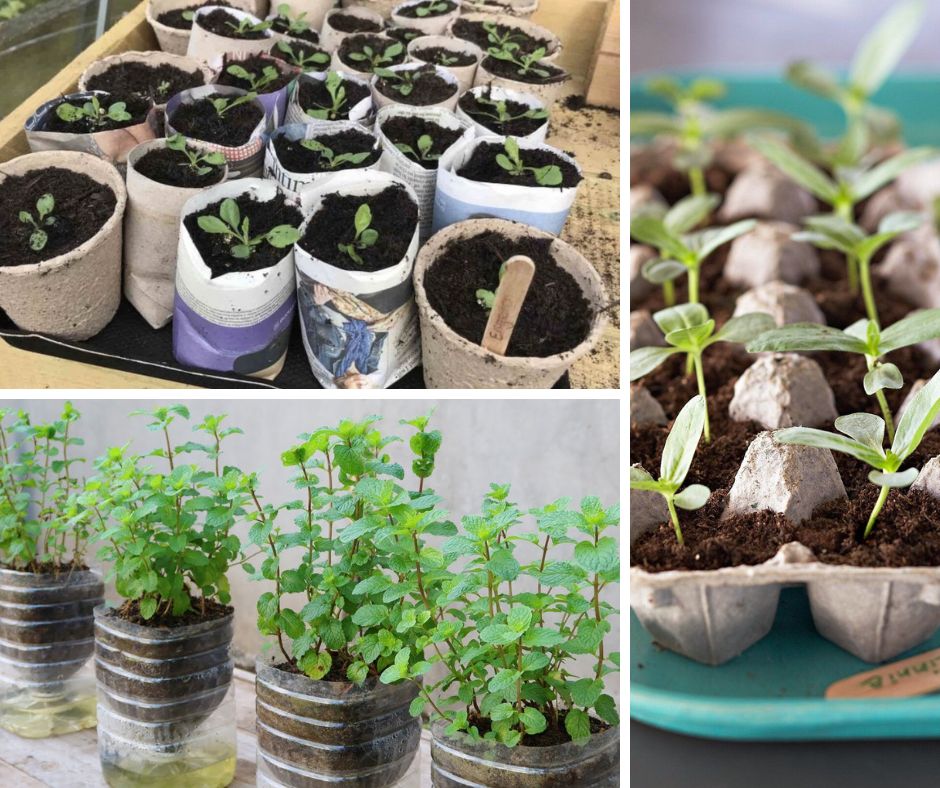
Sourcing Seeds and Plants at Zero Cost
In order to get the seeds and plants you want, you may have to pay a modest fee. Keep in mind that slow solutions and seed-grown plants are always less expensive. Use this method instead of importing plug plants or mature plants for your yard.
However, before you go out and spend money on seeds, see if you can’t find some for free.
Making the Most Out of What You’ve Got
Taking an inventory of what you already have in your garden and at home is always a smart idea before making any purchases.
There are weeds and wild edibles in your garden that you might wish to maintain or transplant to your new veggie patch. Alternatively, you may already have plants in your garden that are suitable companions for your vegetable garden.
Is it possible for you to keep seeds from your pantry and use them in your garden? If the dried peas or beans are organic, local, and untreated, you may be able to sow them.
If you can find organic potatoes at a farmer’s market or a local organic provider, you can plant those instead. Even if you’re not sure, it’s never a bad idea to try something and see what happens.
You should also think about whether or not you can save seeds from the food you buy and plant them. Tomato or squash or pumpkin seeds, for example, are good sources of protein.
You may even be able to replant vegetables from scraps.
Getting Seeds For Free
There’s a good chance you’ll still need or want some seeds. You might be able to get seeds for free from:
- People who already have their own garden.
- Community gardens, gardening organizations, and the like in your neighborhood.
- Organizations in your area that promote seed saving and exchanging.
- Free-of-charge online marketplaces.
- Getting Free Plants and Cuttings
Getting Cuttings & Plants For Free
Look around your neighborhood and ask your friends and neighbors if they have any plants or plant cuttings that they’d be happy to share with you.
Many home gardeners end up with a surplus of seedlings or cuttings that they are ready to give away.
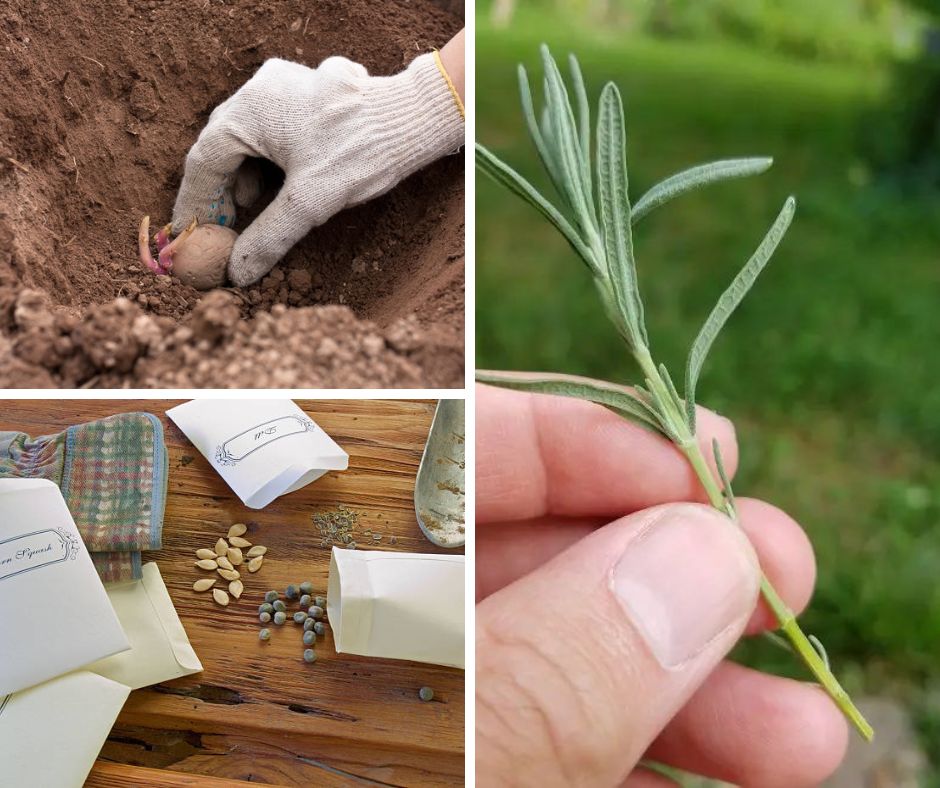
Gardening Knowledge: A Priceless (& Frequently Free)
Learn from the more experienced gardeners you meet, not only for the seeds and free plants you may receive but also for the essential wisdom they may impart on your own gardening endeavors.
Make an effort to connect with people in your circle. However, you should also think about contacting local gardeners online to see if they can offer resources and ideas to assist you in setting up your new garden. Don’t be scared to ask questions if you have any concerns.

